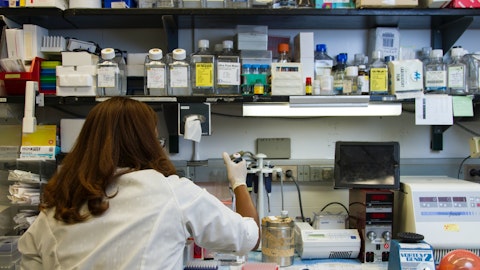Adaptimmune Therapeutics plc (NASDAQ:ADAP) Q4 2023 Earnings Call Transcript March 6, 2024
Adaptimmune Therapeutics plc isn’t one of the 30 most popular stocks among hedge funds at the end of the third quarter (see the details here).
Operator: Hello and welcome to Adaptimmune’s Fourth Quarter and Year-End Conference Call and Business Update. I will now turn the call over to Juli Miller. Juli, please go ahead.
Juli Miller: Good morning, thank you for joining us. Welcome to our Q4 and full-year 2023 update and I refer you to our disclaimer here, as well as our forward-looking statements in this morning’s press release. For the prepared portion of the call, Adrian Rawcliffe, our CEO, is with us, and other members of our management team are available for Q&A. With that, I’ll turn the call over to Adrian. Ad?
Adrian Rawcliffe: Thanks Julie. Thanks everyone for joining today. So I planned today to recap the progress we made in 2023 and share a little bit about our plans for 2024. I’ll be focused primarily on a Afamicel, which will be our first commercial product in our sarcoma franchise. 2023 was a year of transformation for Adaptimmune. We completed a corporate restructuring and a merger with TCR Squared. And following that, we undertook a clinical pipeline review focusing on the highest priority and value assets. We recovered Letecel and PRAME from GSK. I want to remind you that Letecel came with a fully enrolled pivotal trial that has already met its primary endpoint for efficacy at the interim analysis, which was disclosed late last year.
We also submitted the BLA for a Afamicel. This is a significant milestone for adapting, you know, obviously, but it’s also a significant milestone for the sector as the first ever BLA for an engineered cell therapy for a solid tumor indication. As well as the submission, we took the opportunity working with the RMAT designation to understand the FDA’s requirements on a number of areas and de-risk that file and also sought the FDA’s agreement on the opportunity for the second cohort of that SPEARHEAD-1 trial to provide the confirmatory evidence for full approval. Afamicel is the first product in our sarcoma franchise, a franchise that we estimate has PTO sales of up to $400 million. And as such, it’s a beachhead for innovative cell therapy products in the solid tumor space.
It’s the first product of our wholly-owned pipeline of cell therapy products with the most significant of those in clinical development being a product that was previously known as ADPA2M4CD8, but has now been granted the user name of uzatresgene autoleucel or uzacel. Uzacel has been developed in ovarian, bladder and head and neck cancer, and all of this is enabled by our long-term investment in the capabilities needed to be a cell therapy company. That means that at this point, we have the opportunity to transition into a fully integrated commercial stage company, discovering, developing, and now importantly delivering cell therapy products to patients. I want to touch a bit on our launch preparedness. As a Afamicel is currently undergoing its priority review at the FDA.

We’ve been informed that the FDA does not currently anticipate an adcom for Afamicel, but we are clearly on the FDA’s clock now. Everything is proceeding as you would anticipate for a product with priority review and a PDUFA date in August. Afamicel is a highly anticipated product and we intend to be in the position to commercialize Afamicel on approval in August. To that end, I’m delighted to welcome back Cintia Piccina as our Chief Commercial Officer. She will lead our commercial efforts for Afamacel, in due course for Letecel, and the rest of the pipeline that I talked about. We are in the final stages of recruiting the commercial team, with the majority of that headcount secured and the remaining few roles will be in place by the middle of the second quarter.
Same goes for the medical affairs team with the majority of that team recruited and the remaining members of that team due to join us over the next few weeks. We’ve also bolstered the manufacturing team and we’ll be scaling that up to meet the commercial demand for Afamicel. I want to put — remind everybody that we have manufacturer Afamicel in-house at the Navy Yard facility in Philadelphia. We believe this is a key differentiator giving us not only control and the ability to scale demand according to our needs, but also the opportunity to produce Afamicel at a margin that will be very attractive, and we’ve referred previously to a 70% margin for our sarcoma franchise at peak year sales. As you see from this slide, we have a clear plan to stand up the necessary infrastructure and we’re on track to do so for that launch, including a sponsored testing plan for the major four diagnostic and the patient support infrastructure necessary to help patients and the providers navigate through treating patients with Afamicel.
Subject to FDA’s approval around that PDUFA date we anticipate actually infusing our first patients with Afamicel in Q4 2024. We will be updating as we go through this process to register and launch Afamicel. And I want to tell everybody that the first such update will occur on our Investor Day on Thursday, the 18th of April. There we will discuss not only our plans and preparation for the commercial of the first engineered T-cell for solid tumor, but also we — how we see the opportunity in advanced sarcomas, the paucity of existing treatment options, and the opportunity to hear from patient advisory groups and providers about the opportunity represented by Afamicel for these patients. With Afamicel BLA filed and awaiting approval, we’re executing on our plans for our sarcoma franchise.
As I referred to earlier, Letecel has now been recovered from GSK. The pivotal trial has finished enrollment. The primary endpoint for efficacy has been met, and it’s now clear that Letecel is a product in its own right and has the opportunity to go through exactly the same commercial channels that we’ll be developing for Afamicel, resulting in substantial synergies for these overlapping patient populations. We have the opportunity to reach $400 million in peak sales with these cell therapies with an addressable patient population a little north of a thousand patients per year with synovial sarcoma and MRCLS. I just want to make the point that, that is in the United States in the launch indications that we anticipate only. We’re proud of the progress that we made in 2023.
We view this as securing our place on the starting line to make cell therapy products available for people with solid tumors, beginning with our sarcoma franchise. This gives us the immediate opportunity to create near-term commercial value in 2024 and 2025, and set the company up for long-term success with our wholly-owned pipeline of cell therapy products. And with that, I’ll turn over to the operator for Q&A. Operator?
See also 25 Countries with the Largest Coal Reserves in the World and 25 Countries with Highest Crude Oil Production in 2024.
Q&A Session
Follow Adaptimmune Therapeutics Plc (NASDAQ:ADAP)
Follow Adaptimmune Therapeutics Plc (NASDAQ:ADAP)
Operator: Thank you. We will now begin the question-and-answer session. [Operator Instructions] Our first question comes from Graig Suvannavejh of Mizuho Securities. Please go ahead.
Graig Suvannavejh: [Technical Difficulty] has remained unchanged and that rate is 0.0%, so pretty low.
Operator: Greg, your line is live.
Adrian Rawcliffe: Hi, Greg?
Graig Suvannavejh: New disclosure, the risk of retinal vasculitis during the very first injection of product.
Adrian Rawcliffe: Maybe we’ll come back to Greg.
Operator: Our next question comes from Jonathan Chang of Leerink Partners. Please go ahead.
Jonathan Chang: Hi guys. Good morning and thanks for taking my questions. First question, can you walk us through the assumptions around the $400 million U.S. peak sales opportunity for the sarcoma franchise? And then second question, can provide any additional color on the cash runway guidance, specifically on what’s assumed on the payment front from current and past partners. Thank you.
Adrian Rawcliffe: Thanks Jonathan. So I will take the question on the assumptions from the commercial perspective and then I’ll ask Gavin, our CFO, to talk about the cash runway and the cash receipts from our partners, et cetera. So with respect to the $400 million of peak year sales, I want to reiterate that’s a U.S. only number and it also only speaks to the anticipated launch indications in second line advanced sarcomas, but myxoid round cell and synovial sarcoma for Afamicel of synovial sarcoma for Letecel myxoid round cell and synovial sarcoma. Both of those indications, both of those products are characterized by HLA restriction. They’re all HLA-A2, that’s about [$0.45] (ph) of the patients. And they are also targeted therapies in that they have their own, each has their own target.
Afamicel is from MAGE-A4, Letecel is for NY-ESO. So the starting point is incidents of soft tissue sarcomas of about 13,500 patients per year in the United States. You can cut that for the incidence of synovial sarcoma and Myxoid Round Cell, each of those represent 5% to 10% of that total. Then you cut each of those for the HLA at 45% and the target, and what you end up with is show on this slide, which is about 1,000 patients a year coming through that funnel, which about $400 million are for Afamicel and synovial sarcoma. And the remainder, a little over 600, are the incremental patients for Letecel in synovial sarcoma and Letecel in Myxoid Round Cell Liposarcoma. So that opportunity with both of these products adds up to a little over a 1,000 patients and $400 million of PTA sales.
Gavin, do you want to talk about the assumptions on the cash flow going forward?
Gavin Wood: Yes, of course, Ad. Hi, Jonathan. So if we step through this, so if we take our closing liquidity of about $147 million and then over the course of our cash runway period into early January 26, we’ve got three sources of income that we have a high degree of certainty around. The first of those is the smallest, which is the balance on the payment of GBP30 million from GSK. They expect to get that in Q2. The second component R&D tax credits from the U.K. government, we received in January GBP30 million pertaining to the claim for 2022 and we can anticipate smaller amounts as the regime changes, but we’ve got a good line of sight to those over the next couple of years. And the third and the largest component are the payments from Genentech in association with our collaboration with them on our allogeneic platform, two components to that, and these are laid out in the 10-K.
The first are anniversary payments totaling $150 million over the period of five years. The exact shape of that isn’t public and is confidential, but we have two of those payments. And there’s also two milestone, R&D milestone payments of $25 million. We anticipate one of those in 2024 and one of those in 2025. It gives us line of sight to capital north of $300 million. Of course, we continue to look to the markets and continue to have BD conversations to bolster that financing.
Jonathan Chang: Got it. Thanks for taking my questions.
Adrian Rawcliffe: Thanks, Jonathan.
Operator: Our next question comes from Yanan Zhu of Wells Fargo Securities. Please go ahead.
Yanan Zhu: Great. Thanks for taking our questions. On the patient number, the 400 patients for the Afamicel launch, I was wondering how many of those patients can be expected to be reached in the initial 6 to 10 ATCs that might be online? And also, regarding the manufacturing capacity, what is the capacity that you expect to be online at the time of launch. And also a question on ADPA2M4CD8, any guidance in terms of updates on data from surpassed trials? Thank you.
Adrian Rawcliffe: Thanks. So I think the exact split of those patients in those centers will reflect the centers that we stand up first, which one of those actually are. The plan is to start with 6 to 10, but grow fairly rapidly over the first two years of the launch to up to 30 centers. We’ve estimated that something, maybe a little north of 40% of the total patients are currently in those centers. However, we also anticipate, as with other therapies of this nature that there will be increasing concentration of patients eligible for the therapy in the centers where we have established treatment capacity in our treatment centers. So that plan we anticipate increasing over time substantially. And then obviously we’ll be leveraging the existing and well-established referral networks within the sarcoma community and sarcoma Centers of Excellence to ensure that we make Afamicel available to as many patients as possible.
The 30 centers at maximum will be geographically quietly — well quite well distributed across the United States, reducing the need for travel, but we fully anticipate that these patients will travel for this therapy. And I want to point out in that regard, as a one-off therapy, this has the opportunity of being easier for that travel to occur than if it was a constantly repeating therapy where being proximity to home would obviously be preferable. With respect to uzacel, as we are now calling the product previously known as ADPA2M4CD8 that product will — that data that we’ve said for that is it falls into two categories. The first is the Phase 2 trial surpassed three in platinum resistant ovarian cancer. That being a registrational trial, that trial is recruiting, potentially registrational trial.



